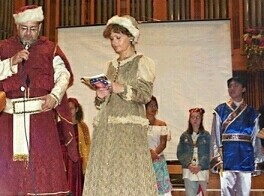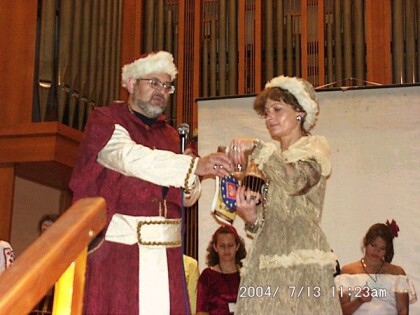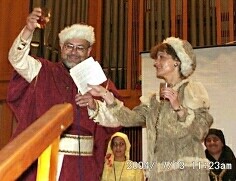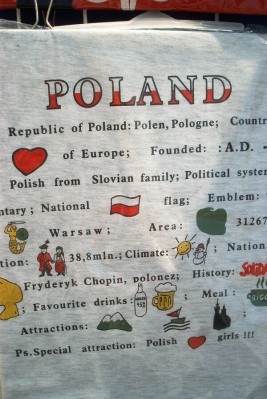POLAND: Performance
This is a traditional costumes of the Polish nobilities, named szlachta. As compared to its counterparts from the Western European countries, as a social class, Polish nobility was quite unique, both in its structure and prerogatives.
Poland used to have a great number of aristocratic families - the society still retains the old ethos and stresses on high culture values.
About ten percent (10%) of the population was noble in Poland, as compared to the one (1%) to two (2%) percent in the rest of Europe. The Polish State was set up to serve the Polish nobleman.
Szlachta had its own culture, its own value system and its own savoir-vivre. Since szlachta was so numerous, its prevailing culture, its way of being and etiquette influenced many areas of life and was by and large accepted by other social classes. Many aspects of this influence can be observed among contemporary Poles.
The favorite dance of nobility was the polonez, which you could hear.
POLONEZ -> /MP3, 1 MB/ HERE download
The polonaise is a stately Polish processional dance, performed by couples who walk around the dance hall.
It was transformed into the most highbred expression of the Polish national spirit and became in the process the most representative of Polish dances throughout Europe.
There are many variations in the way the polonaise may be danced. Throughout, it has to maintain its noble, "upright" image, full of dignity and pride.
The polonaise is usually danced in costumes of the Polish nobility of the 17th century (the kontusz jackets)
Poland used to have a great number of aristocratic families - the society still retains the old ethos and stresses on high culture values.
About ten percent (10%) of the population was noble in Poland, as compared to the one (1%) to two (2%) percent in the rest of Europe. The Polish State was set up to serve the Polish nobleman.
Szlachta had its own culture, its own value system and its own savoir-vivre. Since szlachta was so numerous, its prevailing culture, its way of being and etiquette influenced many areas of life and was by and large accepted by other social classes. Many aspects of this influence can be observed among contemporary Poles.
The favorite dance of nobility was the polonez, which you could hear.
POLONEZ -> /MP3, 1 MB/ HERE download
The polonaise is a stately Polish processional dance, performed by couples who walk around the dance hall.
It was transformed into the most highbred expression of the Polish national spirit and became in the process the most representative of Polish dances throughout Europe.
There are many variations in the way the polonaise may be danced. Throughout, it has to maintain its noble, "upright" image, full of dignity and pride.
The polonaise is usually danced in costumes of the Polish nobility of the 17th century (the kontusz jackets)
A Famous Nobleman's proverb was "When a guest enters the house, God enters also." Poles are known for their hospitality and love of food. If you would come to Poland – welcome! – you could meet network of shops ‘Berti’ with fantastic, traditional Polish food.
A Famous Nobleman's Toast was "Let us love one another." And now, we would like to drink a toast for You, dear iEARN friends, with traditional Polish honey. So.. "Let us love one another."
A Famous Nobleman's Toast was "Let us love one another." And now, we would like to drink a toast for You, dear iEARN friends, with traditional Polish honey. So.. "Let us love one another."
Now we would like to thank you for attention. The melody, you will hear in a moment is known to every Pole Historical Song: HEJNAL (‘The Bugle Call’). The melody may be interpreted as a call to self-sacrifice in the cause of patriotic vigilance and independence.
HEJNAL /MP3, 300 kB/ HERE download
HEJNAL /MP3, 300 kB/ HERE download




